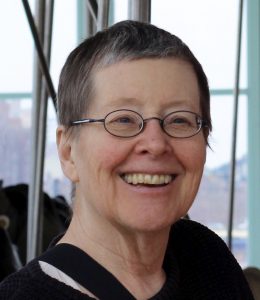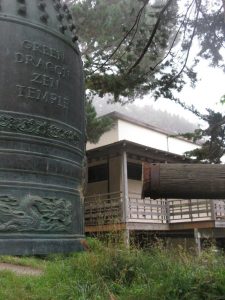
Catherine Gammon talks with NER editorial panel member Gretchen Schrafft about revisiting the days of witchcraft accusations in “Invocation” (NER 39.1), and about the dilemma of living fully as a fiction writer and living fully as a Zen priest.
Gretchen Schrafft: When you submitted “Invocation” to NER you described it as a “prologue” to Nightbirds in an Age of Light, your novel based on the Salem witchcraft trials. Can you talk about the content and structure of the rest of the book? Is the narrative voice similar to what we see here in “Invocation,” or does it change? Does Mercy Lewis remain the central character, or do other figures come to the fore?
Catherine Gammon: After the prologue, the novel progresses through seven sections. The first continues in the voice of the prologue, and the six that follow introduce additional pivotal characters and develop new narrative voices and forms, with recurrence and reprise from the earlier sections.
Titling the prologue “Invocation” arose from a thought of many years ago, when Nightbirds was still gestating but not at all written. One summer afternoon when I was fortunate to be in Paris for the first time, I was attending a performance of Bach’s Mass in B Minor in a church older than Massachusetts. I don’t know Catholic liturgy or music theory, so I don’t know the principles that structure the musical composition of a mass, but I knew I wanted something of the mass’s feeling to define this novel’s form—a whole composed of many voices, both choral and solo, shaped of discrete units that build on one another.
I don’t know how much of this initial organizing idea remains now that the novel is completed, but at a fairly recent stage of revision a wonderful editorial reader suggested I give the book a prologue. I wouldn’t say “Invocation” is the prologue he had in mind, because it was essentially the opening of the novel’s first section, but pulling it out of that section and setting it apart seems to me to invite a reader to understand its themes and concerns as driving the whole—all the subsequent sections, not only the one within which it was born.
Bringing this opening chapter to the fore in this way also allowed me to make a connection with the mass, which begins with a Kyrie, an invocation, and it’s possible this was implicit in the structure from the start. I do think this is what “Invocation” aims for: to summon the spirits. And “Kyrie eleison” translates as “Lord have mercy,” which is apt to the novel’s content, as well as being a play on Mercy’s name.
As for the characters, as the novel develops Mercy Lewis remains central, along with the slave Tituba, and the ministers Samuel Parris, William Burroughs, and Cotton Mather. Throughout, I have invented events and especially encounters and relationships where there are gaps and silences in the record. Certainly no one should expect to read the novel as an accurate history, but it does offer an extensive note on sources, suggesting directions to turn for the history itself.
GS: In addition to being a writer, you spent twelve years at the San Francisco Zen Center, where you were ordained as a Soto Zen priest. Clearly, you have thought long and hard about belief, spirituality, and religion. I’m curious to hear how your Zen studies connect with your impulse as a fiction writer to explore Massachusetts in the late 1600s—a time and place that is remembered in the popular imagination for the severity of its belief system.
CG: This is a complex question, probably more complex than you intend. I do think there are deep connections between this interest in American Puritans and the Zen path I’ve taken, on the one hand, and the dilemma I continue to face between living fully as a fiction writer and living fully as a Zen priest. Because with just one body, you know, it isn’t exactly possible to live in both practices at the same time. I may feel that both are present always, but in any single moment I can actively do only one. I cannot be sitting in meditation or leading a service or giving a dharma talk at the same time that I am putting words on paper. Both devotions are absolute and demand all your love and all your heart.

As I draft this response I am on a Zen retreat led by my teacher, Tenshin Reb Anderson Roshi. Zen retreats are meant to be silent, and free of reading and writing. So this is something that looks like a contradiction. Still, earlier today, I profoundly needed to call up the writer, to invite her back into the room, and I sat down and started studying your questions and responding. And this was a wonderful and perfect thing to do today. There seems to be an inherent conflict between completely following the collective schedule, which is the Zen way, and responding in the moment to the impulse offered by the imagination. Fortunately, it is also the Zen way to see that these apparent conflicts actually support one another.
So this is a convoluted way of getting at your question. My interest in the Salem trials emerged when I was a fellow at the Fine Arts Work Center in Provincetown. I had just discovered William Carlos Williams’s In the American Grain, and his sections on Anne Bradstreet and Cotton Mather and the Puritans stirred my imagination, especially in combination with learning that the pilgrims had landed on the outer Cape before they found Plymouth. I began to dive into reading about the American Puritans in general and the trials in particular. At first I imagined I would write entirely fictionally, about fictional characters, but the more I read—and I read a lot for a long time—the more clear it became that I would write based on the historical figures, many of whose stories are in the records.
When I began this reading I was in a condition of mind that rejected religion in various ways. But I was brought up in the Episcopal church, so when as part of my research I began reading the King James Bible, beyond offering its poetry it also spoke to the spiritual hunger of a sort of religious orphan. And this issue of orphanage runs deeply through Nightbirds, and through the world it’s based on.
As for the austerity and severity of the Puritans, I take this popular view of their world to be somewhat mistaken. Zen is also sometimes seen as austere or severe. Yet both appearances are supported by deep intimacy and joy. Practitioners of both schools wear a lot of black and spend long hours sitting upright and silent in halls that are often too cold, unless they are too hot. Practitioners in both traditions can appear to have given up ease and essential pleasures and pastimes. Both traditions come with rules, and their devotees can be vulnerable to anxiety and self-righteousness over questions of attainment. Both traditions revere their teachers.
Some of these are superficial connections, in the realm of appearance, and of course there are great differences between the traditions, but I do think these appearances mark some deeper connections in terms of the intimacy of community and the cultivation of generosity, wisdom, and compassion, on the one hand, and the dangers of the shadow, on the other. It may also be helpful to remember that the Puritans are the spiritual ancestors of modern Congregationalists and the United Church of Christ, not politically conservative or fundamentalist Christianity.
I began formal Zen practice in 1997, however, long after I had begun my research into the Puritans, and shortly after I began writing the novel. When I left teaching at the University of Pittsburgh to begin residential training at San Francisco Zen Center’s Green Gulch Farm, the manuscript was half finished in first draft at 350 or so pages. I did not go to Zen training with any sense of seeking insight into my fictional Puritans. Rather I had the feeling I was abandoning them for something necessary, and I had no certainty that I would return to them. But as things turned out, my life at Zen Center fed my sense of these characters and their world, and eventually I left residence to return to a world that offered time and space for writing. All of which is simply to say that the relationship of the two explorations is certainly not linear or causal, but they clearly do flow from the same source.
And American Zen does seem to attract spiritual orphans of various kinds.
GS: “The images come from stories she knows are not her own, accounts read, or heard whispered.” This sentence refers to Mercy’s projections of what may have happened to her parents after they were captured by the Abenaki, but I wonder how much it might also apply to your own creative process. Can you talk about how you went about researching this project? What kind of material was most helpful to you? Are there any memorable instances of something you uncovered leading to a creative breakthrough in your storytelling?
CG: First, this is a wonderful observation and one I had not thought of. Consciously, I mean this sentence to accomplish three things: first, to alert the reader that neither Mercy nor my narrator is claiming these racist and stereotypical images of brutality to be accurate or true; second, to develop a motif about the importance of reading and rumor in this community; and third, to signal that these images do come from books written, printed, and read at the time.
And, certainly, reading drove the imagination of this book. I read for years without having a plan of any sort, just wanting to take in all the views we have of that reality, until the characters could begin to appear to me, meanwhile writing much other fiction. Finally, as the time to write drew closer, I visited Danvers to walk in the sites where the crisis started and I also visited Salem. Walking in these historic places contributed to my bodily understanding and gave me a tangible sense of scale. I also have a few memories of places where I wrote certain specific, mostly descriptive passages—the view from my window on a creative research fellowship at American Antiquarian Society in Worcester, Massachusetts, for example, generated some of the snow images. And sitting outdoors in a bunker or cave-like place on the grounds of Djerassi writing by hand in the voice of Tituba helped shape the way that section unfolds.
As for what was most helpful, I’m not sure there can be an answer to this. The manuscript concludes with a seven-page section of notes on sources. Original sources were certainly essential. The trial records had been published in full in 1977 by Paul Boyer and Stephen Nissenbaum, so that in the ’80s and ’90s a large collection of scholarly secondary treatments had developed, and all of these were important to me also. It was wonderful while at the AAS to hold an original 1693 edition of Mather’s Winter Meditations, which is small and fits between the hands, and the size of these early books led to significant uses I would make of them in the fiction centering on Mercy.
But these are just examples. As I said, the note on sources is extensive, and even then not complete.
GS: There’s certainly no shortage of representations of the Salem witch trials, and yet there are still angles that haven’t been sufficiently explored. When I came across the sentence, “The singular they, the plural she—these are the missing pronouns,” it made me suspect you might feel the same way. Variations of this sentence occur more than once in the piece, creating a kind of refrain; why is it so important to call our attention to these “missing pronouns”?
CG: The way the meaning of these words may have shifted over time is interesting to me, and certainly the narrative can embrace a contemporary awareness of complicating traditional gender binaries. But here the novel is working with a different idea: a singular they (and plural she) specific to the condition of these girls and young women, in their state of “affliction,” as it was called, which was the starting point for the wave of witchcraft accusations.
Mercy, when we meet her in “Invocation,” is on the brink between having a mind and observation of her own, a singular point of view, and falling over into the collective, in which each girl in some way surrenders her autonomy of consciousness, her integrity, to the group, and then expresses the group through her singular gestures and body. Mercy’s role throughout is to resist this surrender, to fall into it, to lead it, and to work her way back out again.
So it is this existential moment, this brink, that I am calling attention to with this refrain. As the novel moves forward, we see some of the other young women up close as well, both as the afflictions and examinations spread, and in their aftermath, and all of them work variations on this theme of being swept into something real at the time and then stepping back from it to recognize consequences.
And yes, in writing about the afflicted in this way I want to rescue them from popular representations that portray them as scheming, intentional, acting conspiratorially from lust or greed or resentment or revenge, and so on. I wanted to find a way to enter into their experience as one of confusion and uncertainty in a time and place in which they were so vulnerable. Whether this is more or less true than the popular version, I can’t say, but seeing the accusations as manifestations of delusion rather than malice is much more interesting to me both theoretically and fictionally, and it’s the story of delusion and how it relates to the surrounding realities that I wanted to tell.
GS: What writers do you consider your literary kin?
CG: Well, kinship is a big claim to make, so I will sidestep that a little.
My oldest devotions as a reader have been to Dostoevsky, Emily Brontë, George Eliot, Melville, Henry James, and Kafka. I had read Joyce and Woolf and Faulkner with enthusiasm, but until I went to Iowa for the Writers Workshop I pretty much thought all writers were dead. At the same time, I had been reading Barthelme and Pynchon and Borges and Christa Wolf and Toni Morrison and soon read Carlos Fuentes and Juan Rulfo and later found inspiration in Maurice Blanchot and Lydia Davis and Ingeborg Bachmann and Anne Carson, and really there can be no end to such a list. Recently I’ve loved Exit West and Lincoln in the Bardo and Elmet and Underground Railroad and Yuri Herrera’s Signs Preceding the End of the World. And just now I’m reading Claire Messud’s The Woman Upstairs, which is wonderful.
I feel personal affinities also with the many writers of my generation who have been friends during our youth, poets and playwrights as well as fiction writers. And some of my strongest personal affinities are to visual artists.
But neither these affinities nor these enthusiasms are quite the same as kinship, and obviously I find that harder to define. I may have to leave that to readers to decide.

Catherine Gammon is the author of the novels Sorrow (Braddock Avenue Books, 2013) and Isabel Out of the Rain (Mercury House, 1991), and of shorter work that has appeared in many journals. “Invocation” opens a novel based on the Salem witchcraft trials, Nightbirds in an Age of Light. Some descriptive passages in this chapter depend on original sources, in particular accounts given by Deodat Lawson, John Hale, and Cotton Mather, and records of Tituba’s testimony during examination. The American Antiquarian Society, Djerassi, the Virginia Center for the Creative Arts, and the University of Pittsburgh have contributed to the novel’s completion.
Gretchen Schrafft is a member of the New England Review editorial panel. Her fiction, reportage, and reviews have appeared in Carve, Joyland, Hobart, the Rumpus, the Huffington Post, San Francisco magazine, and elsewhere. She’s a graduate of Middlebury College and began reading for NER as an intern in 2007. She holds an MFA from Oregon State University, and teaches creative writing in and around Seattle, Washington. She is currently at work on a short story collection and a novel.